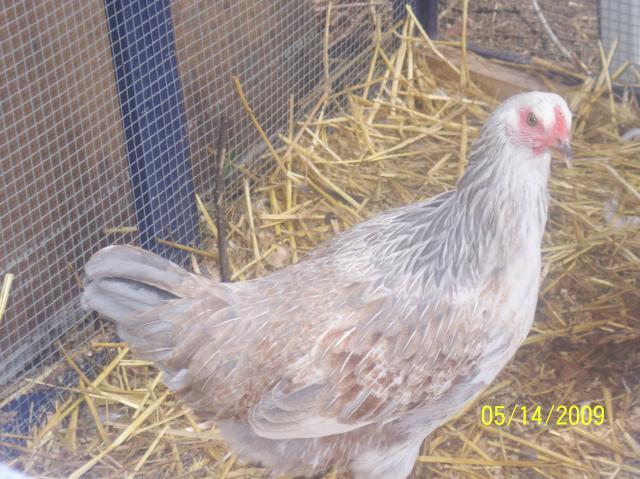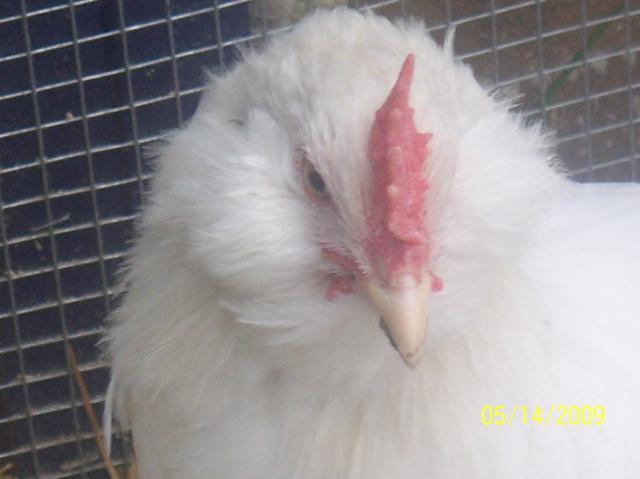Navigation
Install the app
How to install the app on iOS
Follow along with the video below to see how to install our site as a web app on your home screen.
Note: This feature may not be available in some browsers.
More options
You are using an out of date browser. It may not display this or other websites correctly.
You should upgrade or use an alternative browser.
You should upgrade or use an alternative browser.
What breed or gender?
- Thread starter Shesapip
- Start date
Hmm... I would say EE if not for the yellow legs! Definitely a boy though.
EE mix, looks like a definate roo.
- Thread starter
- #4
Thank you both so much!

I am so discouraged, though.

This is my first year (first 2 1/2 months, actually) with chickens and it looks like a lot of the pullets I bought at 8 weeks (at $10 a pop) are actually roosters. I've got people lined up to buy organic eggs and I've been waiting for these girls to mature to laying age.
Now, at best, if I pay the $3 processing fee, I'll have a $13 chicken for dinner.
 Several of them! Plus, the cost of buying new pullets and feeding them until they start laying (or crowing)!
Several of them! Plus, the cost of buying new pullets and feeding them until they start laying (or crowing)!


To make it worse, when I finally found affordable pullets, I drove a great distance to buy them and then brought extras back and sold them! Roosters are popping up everywhere! Of course I'm taking them back and giving their money back.

I am buying sex-links this time!

P.S. Is this a new thread? I'm new to forums.

I am so discouraged, though.

This is my first year (first 2 1/2 months, actually) with chickens and it looks like a lot of the pullets I bought at 8 weeks (at $10 a pop) are actually roosters. I've got people lined up to buy organic eggs and I've been waiting for these girls to mature to laying age.
Now, at best, if I pay the $3 processing fee, I'll have a $13 chicken for dinner.



To make it worse, when I finally found affordable pullets, I drove a great distance to buy them and then brought extras back and sold them! Roosters are popping up everywhere! Of course I'm taking them back and giving their money back.

I am buying sex-links this time!

P.S. Is this a new thread? I'm new to forums.
Sounds to me like you were taken--at 8 weeks with many breeds you can make a pretty good guess as to gender--and $10 for an 8 week bird is a lot unless the bird is purebred exhibition potential or a rare breed.
I think you should contact the person who sold you pullets and ask for a refund.
Breed? Not a clue, and unless I knew he came out of a blue or green egg I would never guess EE--it seems like that is all anyone ever suspects an unknown of being.
I think you should contact the person who sold you pullets and ask for a refund.
Breed? Not a clue, and unless I knew he came out of a blue or green egg I would never guess EE--it seems like that is all anyone ever suspects an unknown of being.
- Thread starter
- #6
Thanks for the input, SonoranSilkies. I do feel I've been taken.
I should clarify - I have another post about an 18-week roo. That one I paid $10 for at 8 weeks. Turns out he's not an RIR, but a production red, and not a pullet as the feed store told me (a local spot that advertised on Craigslist, not a chain). I'm now looking at the other 3 I bought with him and thinking there may be other roos among them. I should post their pics.
This guy I bought as a pullet at 8 weeks for $2.50. Not a bad price, but I wouldn't have bought it and tended it for three months had I known it was a rooster.

I haven't found any info on the net about sexing birds at any age other than 1-3 days old with vent or feather checks. What can I look for at eight weeks?

Thanks again for your feedback.

I should clarify - I have another post about an 18-week roo. That one I paid $10 for at 8 weeks. Turns out he's not an RIR, but a production red, and not a pullet as the feed store told me (a local spot that advertised on Craigslist, not a chain). I'm now looking at the other 3 I bought with him and thinking there may be other roos among them. I should post their pics.
This guy I bought as a pullet at 8 weeks for $2.50. Not a bad price, but I wouldn't have bought it and tended it for three months had I known it was a rooster.

I haven't found any info on the net about sexing birds at any age other than 1-3 days old with vent or feather checks. What can I look for at eight weeks?

Thanks again for your feedback.

I don't recall the specific age at which it is noticeable, but hackle and saddle feathers on males are almost always pointed at the ends, whereas on females the tips are rounded.
And the general rule of comb & wattle development is faster in males than females.
And the general rule of comb & wattle development is faster in males than females.
- Thread starter
- #8
Okay, I'm getting really tweaked!
Here's one that I was SURE was a hen. I named her "Dove" because of her great coloring.
Also, there's a multiple shot of chickens - can you tell if the production red in the back is a roo? I haven't taken any shots of the others because up til now I hadn't suspected they were roos.
Thanks!



I'll have to take photos of the other 3 production reds.
Here's one that I was SURE was a hen. I named her "Dove" because of her great coloring.
Also, there's a multiple shot of chickens - can you tell if the production red in the back is a roo? I haven't taken any shots of the others because up til now I hadn't suspected they were roos.
Thanks!



I'll have to take photos of the other 3 production reds.
Quote:
I'm not one of those
 He has muffs and no waddles to speak of, that screams of EE mix as a definate possibility
He has muffs and no waddles to speak of, that screams of EE mix as a definate possibility
I'm not one of those


Last edited:
Dove is a pullet--look at the shape of the feather itself--not the shape of the lace.

Can't tell on the reds, sorry.

Can't tell on the reds, sorry.
New posts New threads Active threads
-
Latest threads
-
-
Anyone else waking up with bulldogs next to them on Saturdays?
- Started by Sinclair
- Replies: 3
-
Please help injured chick got swollen again😭
- Started by PeeppeepXO
- Replies: 0
-
Anyone else get tired of people joking about eating your chickens?
- Started by catobsessed
- Replies: 5
-
Chick breed ID x3 from Meyer Hatchery bins
- Started by bawk bawk bagawk
- Replies: 0
-
-
Threads with more replies in the last 15 days
-
-
-
Open Contest Waterfowl & Water Photo Contest
- Started by Kiki
- Replies: 75
-
Ended Official BYC Poultry Caption Contest 05-23-25 Pic by AidKD
- Started by TwoCrows
- Replies: 71
-
Solved Attach files picture uploading
- Started by Kiki
- Replies: 62
-
×





